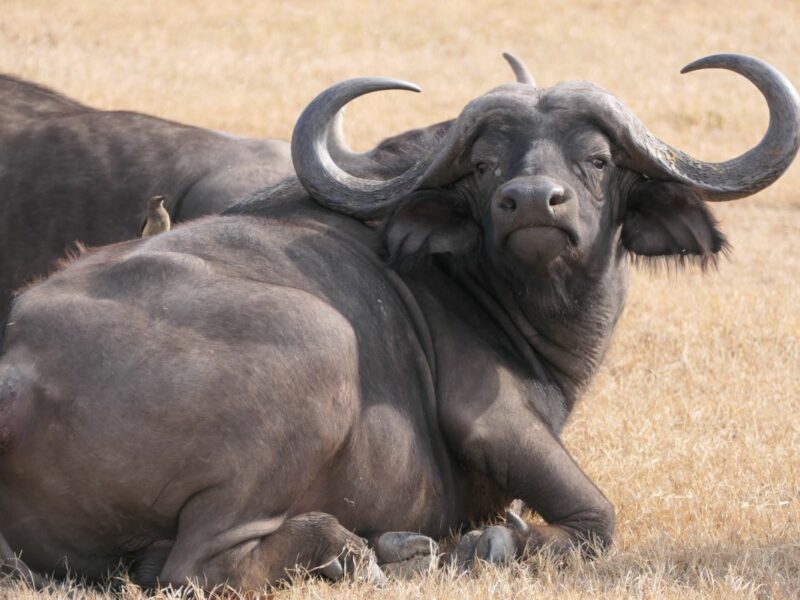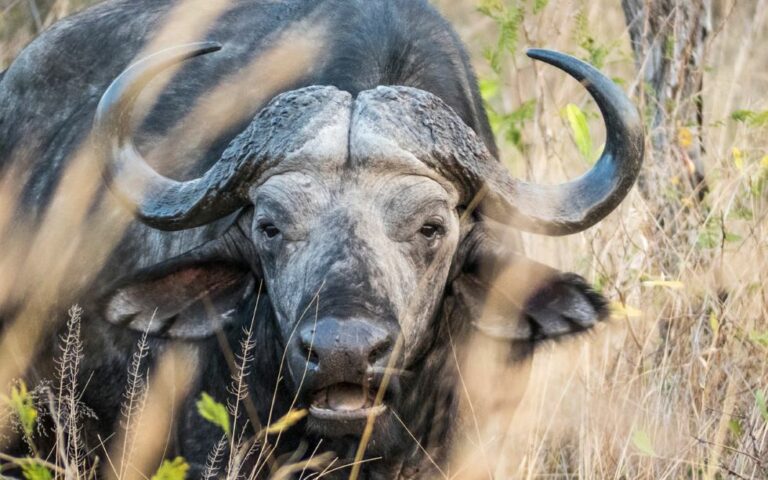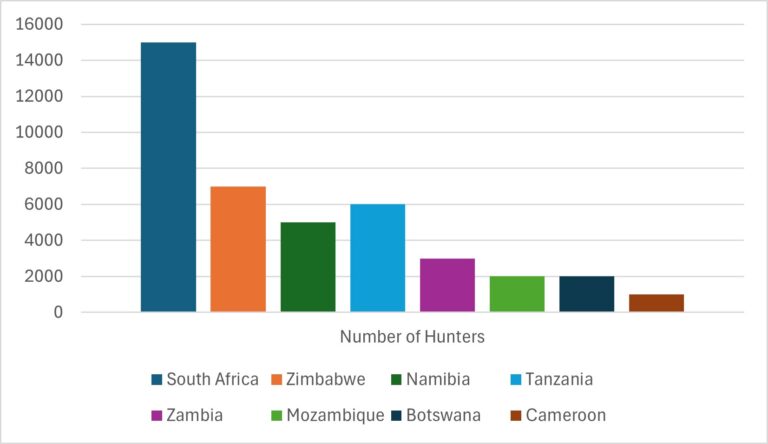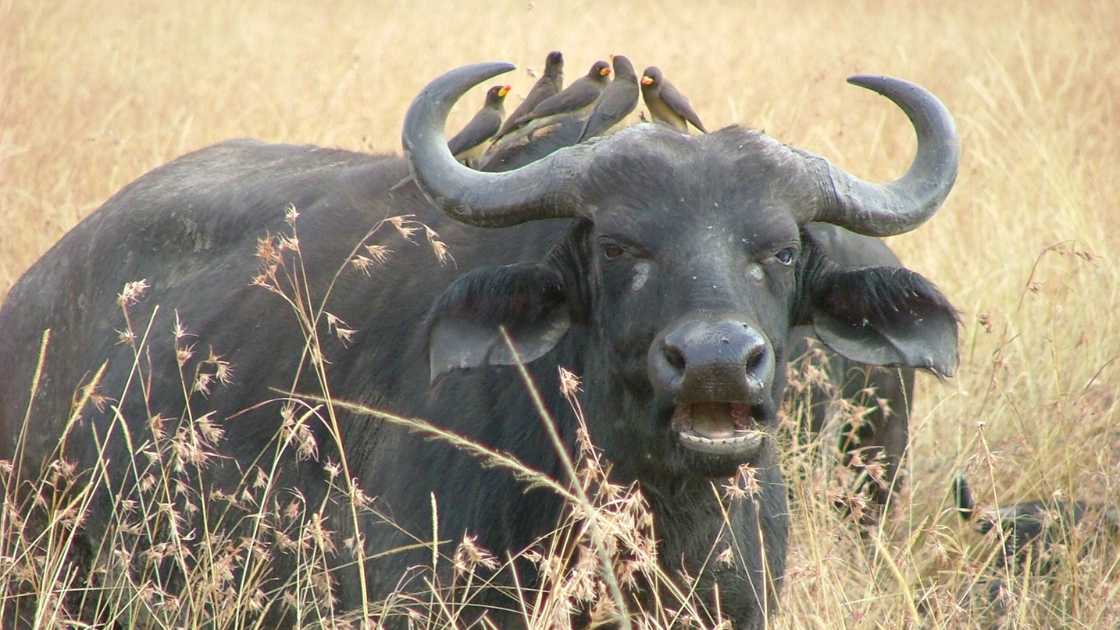African Buffalo hunting is more than just a sport; it is a tradition filled with excitement and challenges. Known for their resilience and unpredictable nature, African Buffalos are a prized target for hunters.
As a member of the “Big Five” these majestic animals are sought-after in various parts of Africa.
In this guide, we will explore African Buffalo hunting in some of Africa’s premier destinations: South Africa, Zimbabwe, Namibia, Tanzania, Zambia, Mozambique, Botswana, and Cameroon.
[DYNAMIC-BLOGTABLEOFCONTENT]
South Africa: The Hub of Modern Buffalo Hunting
Buffalo Hunting Trends
Hunting in South Africa is more than just an adventure—it is an experience steeped in tradition, challenge, and a deep respect for the wild. Here are a few interesting things you might not know about buffalo hunting in this diverse country:
- A Range of Terrains: South Africa offers an incredible variety of landscapes for African buffalo hunting. Whether you are navigating the thick, thorny bushveld of Limpopo or the open, sweeping plains of the Eastern Cape, each setting brings its unique challenges. The dense bush often means you are up close and personal with these powerful animals, making precise shot placement essential.
- The Legendary Dugga Boy: Among the Buffalo, the old solitary bulls, known as “Dugga Boys,” are particularly famous. These grizzled veterans are not only massive but also unpredictable. Hunters treasure these bulls for their impressive horns and the sheer difficulty of the hunt. You might be just a few yards away, with the buffalo staring straight at you, so the pressure is on to make that perfect shot.
Conservation Efforts
South Africa’s conservation efforts are robust, with significant investments in anti-poaching and habitat restoration. Private reserves are crucial to these efforts, often funded by hunting revenues. A strict monitoring system helps keep buffalo populations healthy and ensures sustainable African buffalo hunting practices.
Buffalo Species available
Cape Buffalo (Syncerus caffer caffer)

Zimbabwe: A Rich Legacy of Buffalo Hunting
Buffalo Hunting Trends
Hunting in Zimbabwe is an exhilarating experience, known for its rugged terrain and the sheer intensity of the hunt. I found some interesting facts about hunting in Zimbabwe:
- Challenging Terrain: Zimbabwe’s varied landscapes, from the floodplains of the Zambezi Valley to the dense woodlands of Matetsi, offer some of the most challenging environments for African buffalo hunting. The thick bush and rugged terrain mean that hunters often need to track buffalo on foot for hours, sometimes days, making it a true test of endurance and skill.
- The Big Herds: Unlike other places where buffalo are often hunted as solitary animals, buffalo hunting in Zimbabwe frequently involves encountering large herds. These herds can number in the hundreds, adding a unique dynamic to the hunt. The presence of so many Buffalo means that hunters must be patient, waiting for the right moment to make a clean shot, and ensuring precise shot placement amidst the movement and chaos of the herd.
Conservation Efforts
Despite challenges with poaching, Zimbabwe remains committed to conservation. The CAMPFIRE (Communal Areas Management Programme), which involves local communities in wildlife management, has been particularly successful. This program was initiated in 1989 and includes 36 of Zimbabwe’s 57 districts. CAMPFIRE earns revenue through safari hunting, the sale of animal products, and tourism contracts.
Buffalo Species available
Cape Buffalo (Syncerus caffer caffer)

Namibia: The Conservation Model
Buffalo Hunting Trends
Hunting in Namibia is a distinctive experience that presents its own set of challenges and rewards compared to other African destinations. Here are some key insights into hunting in Namibia:
- The Caprivi Strip: The Caprivi Strip, now called the Zambezi Region, is Namibia’s go-to spot for African buffalo hunting. This lush, riverine area stands in stark contrast to the rest of Namibia’s dry landscape. Bordered by several rivers, the region’s dense vegetation and wetlands create an ideal environment for buffalo. However, this also means hunters must navigate thick bush and marshy terrain, making the hunt both physically demanding and exciting.
- Smaller, Wary Herds: Unlike other regions where buffalo roam in large herds, hunting in Namibia often involves tracking smaller groups or even solitary bulls. This requires hunters to be more strategic and patient, as locating these smaller herds can be tricky. Once you do find them, these buffalo are typically more alert and cautious, demanding a careful approach and precise shot placement for a successful hunt.
- The Impact of Weather: The weather in Namibia, especially in the Caprivi Strip, can significantly influence African buffalo hunting. Seasonal flooding in the region can make accessing certain hunting areas more challenging, but it also tends to concentrate the buffalo, creating better hunting opportunities.
Conservation Efforts
Namibia’s approach to buffalo conservation and hunting is quite strategic, balancing ecological sustainability with economic benefits:
- Disease-Free Buffalo: Namibia places a high value on disease-free buffalo, which is crucial for both tourism and hunting. These buffalo are managed carefully to ensure they do not pose a threat to cattle.
- Economic Impact: Buffalo hunting contributes significantly to the local economy. It provides income through hunting permits, tourism, and live sales in buffalo.
Buffalo Specie available
Cape Buffalo (Syncerus caffer caffer)

Tanzania: The Wild Frontier of Buffalo Hunting
Hunting in Tanzania
- Abundant Buffalo Population: When buffalo hunting in Tanzania the country boasts a large and healthy population of Cape Buffalo, particularly in areas like the Selous Game Reserve, Ruaha National Park, and Serengeti National Park. These are top destinations for African Buffalo hunting, where large herds and rugged terrain offer a true test of hunting skill. The trend is toward traditional, fair-chase hunting, attracting those seeking an authentic African hunting
- Prime Hunting Locations: The country offers some of the best hunting grounds in Africa. Areas like Kizigo West and Maswa are renowned for producing high-quality buffalo trophies, with some buffalo horns measuring over 45-48 inches.
Conservation Efforts
Tanzania is dedicated to safeguarding the African Buffalo, particularly the Cape Buffalo, through a range of conservation strategies, such as national parks, anti-poaching measures, community conservation programs, and some research and monitoring.
Buffalo Species available for hunting
Cape Buffalo (Syncerus caffer caffer) and Forest Buffalo (Syncerus caffer nanus)
Zambia: The Heart of African Buffalo Country
Buffalo Hunting Trends
African Buffalo Hunting in Zambia offers a thrilling and authentic experience, deeply rooted in the country’s wild landscapes. Here are some fascinating insights into hunting in Zambia:
- The Luangwa Valley: The Luangwa Valley stands out as one of Zambia’s premier locations for African Buffalo hunting. This area is renowned for hosting some of the continent’s largest buffalo herds, spread across a vast and untamed wilderness. The thick bush and dense forests along the Luangwa River create an environment where close encounters with buffalo are common.
- Kafue National Park: Renowned as one of Africa’s largest and most ecologically diverse parks, Kafue National Park is a prime location for hunting in Zambia. The park’s terrain is incredibly varied, featuring everything from vast savannas to thick woodlands and marshy wetlands, each offering distinct challenges for hunters. The buffalo that roam Kafue are noted for their formidable size and strength, making them a sought-after quarry.
- The Chobe Floodplains: Situated in southwestern Zambia, near the borders with Botswana and Namibia, the Chobe Floodplains are a seasonal hotspot for African Buffalo hunting. During the dry season, buffalo herds migrate to these plains in search of water and grazing lands. The ever-changing landscape requires hunters to be adaptable, as conditions can shift dramatically with the seasons. On the floodplains, longer shots are often necessary, demanding pinpoint shot placement to bring down these formidable animals.
Conservation Efforts
Zambia’s conservation efforts include community-based natural resource management (CBNRM). The Zambian Wildlife Authority (ZAWA) collaborates with local communities to ensure hunting revenues support conservation and development. Anti-poaching efforts are a priority, with increased patrols and modern technology utilized to protect wildlife.
Buffalo Species available
– Cape Buffalo (Syncerus caffer caffer)
.jpg)
Mozambique: The Emerging Buffalo Hunting Destination
Buffalo Hunting Trends
Hunting in Mozambique offers a unique and exhilarating experience, characterized by diverse terrains, and robust buffalo behavior. Mozambique is emerging as a top destination for African buffalo hunting, especially in the Coutada hunting blocks and Niassa Reserve.
- Buffalo Behavior in Mozambique: In Mozambique, Buffalo are known for their robust and sometimes unpredictable nature. They are highly alert and can react aggressively if they sense danger. This makes shot placement particularly crucial; a well-placed shot is essential for a clean kill, minimizing the risk of a dangerous confrontation.
- Seasonal Challenges: Mozambique’s climate can significantly impact African buffalo hunting. The wet season, which brings heavy rains, can alter the landscape, creating challenges for access and tracking. Conversely, the dry season often leads to buffalo congregating around water sources, which can make finding them easier but also means hunters must deal with potentially more challenging shots due to the increased number of animals in concentrated areas. Understanding these seasonal patterns can be key to effective hunting and shot placement.
Conservation Efforts
Mozambique focuses on habitat restoration and anti-poaching initiatives. The government, in partnership with international organizations, invests in rebuilding wildlife populations and protecting critical habitats. Community involvement is key, with local populations benefiting from hunting revenues and participating in conservation efforts.
Buffalo Species available
Cape Buffalo (Syncerus caffer caffer)
Botswana: The Land of Giants
Hunting in Botswana
Botswana is known for its large buffalo herds, particularly in the Okavango Delta and Chobe region. Hunters here often target old, solitary bulls, known as “dagga boys.” The trend in Botswana is towards exclusive, high-end hunting experiences, focusing on quality over quantity.
- Buffalo Behavior: Botswana’s buffalo are known for their strong and sometimes aggressive behavior. They are highly aware of their surroundings, and if threatened, they can become unpredictable. This makes precise shot placement even more important. A well-placed shot helps avoid dangerous confrontations and ensures a humane hunt. The buffalo’s natural wariness adds an element of excitement and challenge to the hunting experience.
- Seasonal Dynamics: The seasonal changes in Botswana can greatly impact African buffalo hunting trips. During the wet season, buffalo herds are more dispersed across the lush landscapes, making tracking more challenging. In the dry season, however, buffalo congregate around water sources, leading to more concentrated hunting opportunities but potentially more challenging shots due to the higher density of animals.
Conservation Efforts
Botswana is committed to large-scale conservation, including protecting migratory routes and habitats. Anti-poaching efforts are robust, with increased patrols and advanced technology. Revenue from hunting permits supports conservation projects and community development programs.
Buffalo Specie available
Cape Buffalo (Syncerus caffer caffer)

Cameroon: The Last Frontier of Buffalo Hunting
Buffalo Hunting Trends
- Cameroon is often referred to as the “last frontier of buffalo hunting” because it is one of the few remaining places where African Buffalo can be hunted in their natural habitat outside of national parks.
- Cameroon offers a unique African buffalo hunting experience, with hunts in the savannah and forested regions, particularly in the Adamawa and Bénoué regions. The trend is towards traditional, fair-chase hunting, with an emphasis on sustainability.
Conservation Efforts
- Cameroon’s conservation efforts focus on protecting critical habitats and reducing human-wildlife conflict.
- The government collaborates with international organizations to implement programs that protect wildlife corridors and combat poaching. Community involvement is crucial, with local populations benefiting from hunting revenues and participating in conservation initiatives.
Buffalo Species available
- Forest Buffalo (Syncerus caffer nanus) and West African Savannah Buffalo (Syncerus caffer brachyceros)
Requirements and Permits
Every country has its own set of rules and requirements for dangerous game hunting, so it is important to check the specifics of your destination. To avoid any last-minute surprises, make sure to have a good chat with your outfitter before you head off on your African safari.

Interesting Data for Buffalo Hunting
South Africa
- Income from Buffalo Hunting: According to recent reports, the income from hunting in South Africa, including buffalo, is substantial. The hunting industry contributes over $2 billion annually to the South African economy. Specifically, buffalo hunting is a high-value segment of this industry.
- Total Number of Hunters: Estimates suggest around 10,000 to 15,000 international hunters visit South Africa annually, with a sizeable portion targeting buffalo.
Zimbabwe
- Income from Buffalo Hunting: Zimbabwe’s hunting industry generates approximately $250 million annually. Buffalo hunting contributes a huge portion.
- Total Number of Hunters: Around 5,000 to 7,000 international hunters visit Zimbabwe annually, with a notable percentage targeting buffalo.
Namibia
- Income from Buffalo Hunting: Namibia’s hunting industry generates about $200 million annually. Buffalo hunting is a high-value activity, contributing to this revenue.
- Total Number of Hunters: Rough estimates indicate that Namibia hosts around 3,000 to 5,000 international hunters each year, with buffalo being a sought-after species.
Tanzania
- Income from Buffalo Hunting: Tanzania’s hunting industry generates roughly $150 million annually. Buffalo hunting is a significant part of this sector.
- Total Number of Hunters: Approximately 4,000 to 6,000 hunters visit Tanzania annually, with buffalo being a major target.
Zambia
- Income from Buffalo Hunting: Zambia’s hunting sector is valued at around $100 million annually, with buffalo hunting contributing a notable share.
- Total Number of Hunters: Estimates suggest 2,000 to 3,000 international hunters visit Zambia annually, with a portion targeting buffalo.
Mozambique
- Income from Buffalo Hunting: Mozambique’s hunting industry generates approximately $50 million annually. buffalo hunting contributes to this revenue.
- Total Number of Hunters: Around 1,500 to 2,000 international hunters visit Mozambique each year, with buffalo being a popular target.
Botswana
- Income from Buffalo Hunting: Botswana’s hunting industry contributes about $80 million annually, with a massive portion from high-value species like buffalo.
- Total Number of Hunters: Botswana hosts around 1,000 to 2,000 hunters annually, with buffalo being a sought-after species due to its exclusivity.
Cameroon
- Income from Buffalo Hunting: Cameroon’s hunting industry generates about $30 million annually. Buffalo hunting is a growing sector within this market.
- Total Number of Hunters: Approximately 500 to 1,000 international hunters visit Cameroon each year, with buffalo being a key species.

Buffalo hunting, especially in Africa, comes with a significant price tag due to several key factors
Rarity and Conservation Needs
African Buffalo, especially the Cape Buffalo, holds a special status among game species. This makes conservation efforts essential, leading to a limited number of hunting permits.
Risk and Challenge
Buffalo hunting comes with significant risks. These animals are notorious for their unpredictable and aggressive behavior, making the hunt dangerous and demanding an important level of skill and preparation. The necessity for skilled guides, specialized gear, and safety precautions contributes to the overall cost.
Strict Regulations and Permitting
In many African countries, buffalo hunting is tightly regulated through stringent licensing and permit requirements. These permits are costly and often include hefty fees for both the right to hunt and the export of trophies.
Logistical Planning and Expertise
Organizing an African buffalo hunt involves extensive logistical arrangements, including transport, accommodation, and professional hunting services. The involvement of skilled trackers, guides, and sometimes veterinarians, further adds to the expense.
High Market Demand:
The desire for buffalo hunting experiences remains strong among hunters who seek a challenging and prestigious adventure. This demand pushes prices higher, as hunting outfitters recognize that hunters are willing to pay a premium for such an opportunity.
African Buffalo Hunting: Special and Highly Sought-after
The Challenge and Danger
- Unpredictability: African Buffalo, especially the Cape Buffalo, are known for their unpredictable and aggressive behavior. They are often referred to as “The Black Death” or “Widowmaker” because they can be highly dangerous when wounded or cornered.
- Physical Stature: These animals are massive, with bulls often weighing up to 1,000 kilograms (about 2,200 pounds). Their sheer size makes them formidable opponents.
- Mental Toughness: A buffalo hunt tests a hunter’s patience, skill, and mental fortitude. The slightest mistake can turn the hunter into the hunted, making it an adrenaline-pumping experience.
Connection to African Tradition
- Cultural Significance: In many African cultures, the buffalo is seen as a symbol of strength and resilience. For centuries, it has been revered, and hunting it has become a rite of passage in some traditions.
- Historical Legacy: Buffalo hunting has a long history in Africa, with famous hunters and explorers of the past often seeking out these animals. Participating in a buffalo hunt connects modern hunters to this rich heritage.
The Experience of the Hunt
- Authentic African Wilderness: Buffalo are typically found in some of the most remote and wild areas of Africa, such as the savannas, dense thickets, and riverine forests. The hunt immerses you in untouched nature, offering a deep connection with the African landscape.
- Tracking Skills: Hunting buffalo often involves hours of tracking, reading signs, and understanding the environment. The skill required to get close to a herd or a lone bull adds to the experience’s uniqueness.
- Teamwork and Strategy: Buffalo hunts are rarely solo endeavors. They often require a coordinated effort between the hunter, guides, and trackers, making it a highly strategic and team-oriented experience.
The Trophy
- Majestic Trophies: The horns of a mature Cape buffalo are impressive, with some spreading over 40 inches across. These trophies are not just physical rewards but symbols of the hunter’s success, skill, and bravery.
- Lifetime Achievement: Successfully hunting an African buffalo is often seen as a pinnacle achievement in a hunter’s career. The stories, memories, and the trophy itself become cherished parts of the hunter’s legacy.
HAPPY HUNTING!
Author: R du Toit
